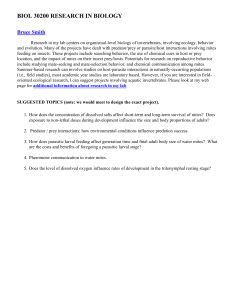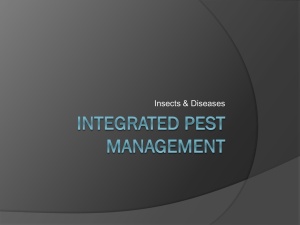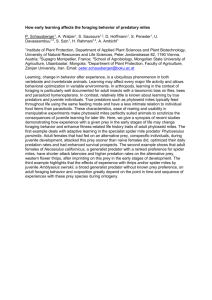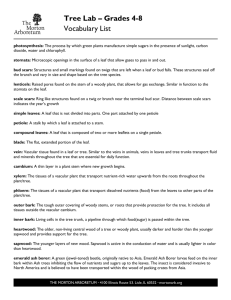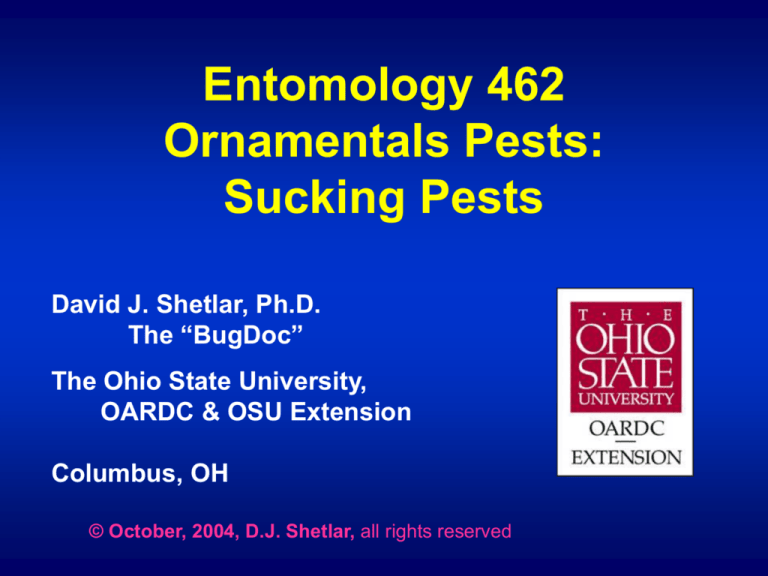
Entomology 462
Ornamentals Pests:
Sucking Pests
David J. Shetlar, Ph.D.
The “BugDoc”
The Ohio State University,
OARDC & OSU Extension
Columbus, OH
© October, 2004, D.J. Shetlar, all rights reserved
Woody Ornamental Pest Groups
Sucking Pests
Thrips (Thysanoptera)
True Bugs (Hemiptera)
Plant/Leaf bugs, Lace Bugs
Bug-like Insects (Hemiptera)
Leaf/Plant/Tree hoppers, Psyllids, Aphids,
Whiteflies, Mealybugs, Scales
Mites (Acarina)
Spider mites, Eriophyid mites
Woody Ornamental Pest Groups
Sucking Pests - Signs
Plant Distortion Leaf & stem twisting & curling
Dead spots
Excrement Deposits Tar spots - true bugs, lace bugs, thrips
Honeydew & Sooty Mold
Foliage Discoloration Spots & Stipples
Yellowing & Bronzing
Honeylocust leaflet distorted.
Sooty mold from scale honeydew.
Cuban Laurel (Ficus) thrips leaf
distortion.
Tarspots from lace bugs.
Woody Ornamental Pest Groups
Sucking Pests - Thrips
•
•
•
•
Cause streaking of flowers or spotting of
foliage.
Occasionally cause foliage distortion.
Usually produce tiny tar spots.
Have complicated life cycle with nonfeeding “prepupa” and “pupal” stages.
eggs nymph 1 nymph 2 “prepupa” “pupa” adult
(larva)
(larva)
(Thrips specialists often call the nymphal stages “larvae” which should really be
used with insects that have a complete life cycle!)
There are actually few thrips that are common pests of ornamental plants.
The pear thrips occasionally attacks sugar maple in the spring. In this
case, overwintered adults insert eggs in the veins of expanding maple
leaves. The damage causes the leaves to distort and ragged holes may
be formed.
Several species of flower thrips cause streaking and spotting of flower
petals. These are most noticeable in roses and some perennials.
The greenhouse thrips commonly damages a variety of broadleaf
evergreens in southern states. Attacks result in bronzed foliage. Upon
close inspection, the leaves will be covered with tiny tarspots and
numerous speckles where cell contents were removed by the thrips.
The privet thrips causes similar damage to privet in northern states.
Leaves first appear yellowed and then turn bronze or brown.
The Cuban laural thrips causes severe stunting, discoloration and folding
of ornamental figs.
Pear thrips on maple leaf.
Flower thrips on leaf.
Note small tarspots and
blanching due to cell
contents being removed.
Woody Ornamental Pest Groups
Sucking Pests – Plant/Leaf Bugs
•
•
•
•
•
Usually feed by injecting salivary digestive juices
into leaf tissues which cause round to irregular
necrotic spots.
Adults form “tar spots” with excrement.
Heavy feeding by adults or nymphs on young
foliage can cause severe foliar distortion.
Most overwinter as eggs inserted into host plant
tissues though some overwinter as adults.
Adults have typical “bug” look.
Ash plant bug adult.
Tarnished plant bug, a
general plant pest.
Fourlined plant bug, note
damage below.
Tarnished plant bug damage
& nymph.
Plant bugs are commonly called leaf bugs and almost all have the
typical bug shape with a pentagonal pronotum, a triangular mesonotum,
and a diamond shaped area where the membrane areas of both
forewings cross.
Almost every plant has its own species of plant bug, but there are
several species that are generalists feeders. The tarnished plant bug is
common on a variety of woody shrubs, perennials and even annual
flowers. The fourlined plant bug is common on smaller shrubs and
perennials.
Most plant bugs produce irregular damage spots by liquefying leaf
tissues with their salivary secretions during feeding. When damage
occurs to young, expanding leaves, the leaves can be severely distorted
and stunted.
The plant bugs produce tarspots rather than honeydew.
Controls are rarely necessary, and if needed, applications of contact
pesticides should be made before the young nymphs have had
sufficient time to cause extensive leaf damage.
Woody Ornamental Pest Groups
Sucking Pests – Lace Bugs
•
•
•
•
•
Pronotum and wings modified into highly
reticulated (lacy) surface.
Nymphs usually spiny.
Produce “tar spot” excrement.
Usually remain in groups on leaf
undersurfaces.
Feeding produces yellow speckles on leaf
surfaces.
Azalea lace bug damage. Note
conspicuous leaf speckling.
Typical lace bug
adult. Note tar spots.
Lace bug nymphs.
Lace bugs that attack
deciduous plants overwinter
as adults. Those that attack
broadleaf evergreens
overwinter as eggs.
Sassafras lace bug
adults. Most lace bug
females attach their
eggs to leaves with
their excrement.
There are many species of lace bugs which attack a variety of deciduous
and evergreen broadleaf trees and shrubs. Several species (e.g., the
hawthorn lacebug) infest a large number of plants, but most species have
rather limited host preferences.
Lace bugs that attack deciduous plants generally overwinter as adults
under flaps of bark or in the leaf litter around their hosts. Lace bugs that
attack broadleaf evergreens overwinter as eggs glued to host leaves with
excrement (a tarspot like material).
Most species have several generations each season.
Almost all lace bugs live on leaf undersurfaces where they feed by
removing the cell contents of several cells in any given area. This usually
results in a small yellow to white spot appearing on the upper surface.
Heavy feeding can cause general yellowing or blanching of host foliage.
Control can be achieved by using contact pesticides, including
insecticidal soaps and oils, but these need to be directed to leaf
undersurfaces.
Woody Ornamental Pest Groups
Sucking Pests - Aphids
•
•
•
•
Pear-shaped insects with long antennae and
diagnostic cornicles on abdomen.
Most alternate between sexual and asexual
forms.
Most alternate between spring hosts (usually
woody plants) and summer hosts (usually
annuals or herbaceous plants).
Asexual form females are parthenogenic
(don’t mate) and ovoviviparous (give live
birth).
Goldenrod aphids, winged and
wingless forms.
Milkweed aphids. Note paired
cornicles (black “tailpipes”)
which produce an alarm
pheromone not the honeydew.
White pine aphids.
Aphid eggs
on pine
needle.
Cinera pine aphids.
Birch leaf aphids. Note honeydew
on leaf tip which is being eaten by
carpenter ants. Ants often protect
and move aphids around in order
to “harvest” the honeydew.
Aphids are often called “ant
cows”!
Black bean aphids on
winged euonymus leaves
which they distort.
Generalized diagram of an aphid life cycle showing a species that alternates
asexual and sexual forms along with alternation of hosts.
Woody Ornamental Pest Groups
Sucking Pests - Psyllids
•
•
•
•
Sometimes called jumping plantlice.
Adults look like miniature cicadas which jump.
Nymphs may look like flat scales.
Produce honeydew.
Acacia psyllid adults.
Boxwood psyllid nymph. The
nymphs feed on expanding leaves,
causing them to cup. The nymphs
produce wax rather than honeydew.
Boxwood psyllid adults
actively jump and fly when
disturbed. They are known
to occasionally bite when
they land on human skin.
Adults insert eggs into buds
and die by mid-summer.
Woody Ornamental Pest Groups
Sucking Pests - Cicadas
•
•
•
•
•
Cicadas are commonly called “locusts” because
our European forefathers believed them to be
singing tree grasshoppers.
Cicada nymphs feed on the roots of plants.
Periodical cicadas take 13 or 17 years to develop,
depending on the species.
Dog-day or annual cicadas take one to two years to
develop.
Females damage small branches by inserting eggs.
Annual cicada adult.
Periodical cicada adult.
Cicada “shell”
(actually the cast
nymphal skin).
Periodical cicada adult
emerging from nymphal skin.
Tree branches flagged by cicada
egg laying.
Woody Ornamental Pest Groups
Sucking Pests - Leafhoppers
•
•
•
•
•
Wedge-shaped insects that run sideways and
readily jump.
Nymphs and adults produce small white to yellow
spots on leaves.
Produce honeydew, some “shoot” the honeydew
some distance (these are often called
sharpshooters).
A few transmit plant diseases.
Some cause stunting of plant growth – hopperburn.
Typical leaf
speckling from
rose leafhoppers.
Rose
leafhopper
adult.
Rose
leafhopper
nymph.
Phlox plants with puckered
leaves, caused by leafhopper
feeding.
Phlox leafhopper nymphs
on leaf undersurface.
Woody Ornamental Pest Groups
Sucking Pests - Planthoppers
•
•
•
•
Usually wedge-shaped insects that are larger than
most leafhoppers and jump when disturbed.
Nymphs and adults usually feed on stems and
produce waxy threads.
Produce honeydew which is usually thrown some
some distance from the insect(s).
Rarely cause damage.
A planthopper nymph among
waxy filaments.
Cluster of
planthopper
adults.
Woody Ornamental Pest Groups
Sucking Pests - Spittlebugs
•
•
•
•
•
Nymphs excrete thick honeydew-like material in
which bubbles are formed and the nymphs hide.
Adults are boat-shaped and can jump.
“Spittle” can drip onto foliage and encourage
growth of sooty mold.
Instructor states that these insects should be called
“anal-bubble-bugs” because they blow the bubbles
in the spittle mass using a chamber in the anus!
Feeding punctures and moisture may assist
diseases.
Pine spittlebug mass on
Scotch pine branch.
Pine spittlebug adult
emerging from nymphal
skin.
Woody Ornamental Pest Groups
Sucking Pests - Mealybugs
•
•
•
Mealybugs are common on tropical and
subtropical plants, but a few can survive
temperate climates.
Adults and nymphs produce honeydew.
Many are parthenogenic but most produce eggs in
waxy filamentous masses called ovisacs.
eggs in ovisac nymph “pupa” winged adult male
nymphlike female
Woody Ornamental Pest Groups
Sucking Pests - Scales
•
•
•
Scale insects are highly modified, often having lost
all features that would identify them as insects.
Adult females usually have no wings, functional
legs or obvious segmentation.
Though there are about five families of scales,
most divide them into soft scale or armored scale
groups.
Many are parthenogenic and ovoviviparous but
most produce eggs and have winged males.
Soft Scales
Armored Scales
No shell or test, body
covered with leathery
exoskeleton.
Body covered by waxy
shell called a test.
Usually large and oval in
shape (1/8” or larger).
Usually small and round,
oval or drop-shaped (less
than 1/8” long).
Produce honeydew.
No honeydew produced.
Females produce 100s to Females usually produce
1000s of eggs.
<100 eggs each.
Nymphs and early
females remain mobile.
Second instar and adults
not mobile.
Fletcher scale adults on arborvitae.
Note characteristic shape.
Spruce bud scales which
are commonly mistaken for
branch buds.
Pine tortoise scale
mature females on
stem.
Pine needle scale
winged male in
search of an
unmated female.
Pine needle scale
second instar
nymphs and male
“pupae” on needles.
Cactus scale.
Black pine leaf scales.
Hemlock fiorinia scales.
Rose scales
Pine needle scale females.
Note pinkish eggs at end of
scale test (shell) and a settled
crawler at upper left.
Group of pine needle scale
settled crawlers (tan) and a
couple of fresh crawlers (pinkish)
in color.
Woody Ornamental Pest Groups
Mites
Spider Mites - Tetranychidae
Upper surface/ lower surface/ both
Warm-season & Cool-season
Eriophyid Mites - Eriophyidae
Rust Mites
Gall Mites
False Spider Mites - Tenuipalpidae
Privet mite - Citrus flat mites
Most spider mites can be grouped as “warm-season” or “cool-season”
mites. Warm-season mites seem to perform best when temperatures are
above 70°F, rainfall is sparse, but humidity is moderate. Cool-season
mites do best when temperatures range between 45°F and 75°F. Warmseason mites generally build populations between mid-May through
September while cool-season mites are most active between mid-March
and mid-June and again between late September and early December.
Warm-season mites usually overwinter as dormant eggs (though the
twospotted spider mite overwinters as females), while cool-season mites
oversummer (aestivates) as eggs and also overwinter when daily
temperatures generally go below freezing.
Each species can usually produce silk, but some produce more silk than
others. Some species inhabit leaf upper surfaces while others inhabit the
lower surface.
These mites feed by tearing small holes into cells and removing the
contents. This produces tiny yellow to white speckles. Extensive feeding
results in yellowing and eventually browning (=bronzing) of the foliage.
Most spider mites are controlled naturally by predators, but chemical
controls are occasionally necessary to keep damage to acceptable levels.
Thorough coverage is essential to success due to the small size of mites.
Honeylocust spider mites inhabit
leaf undersurfaces.
Oak mites inhabit the upper leaf
surface.
European red mite overwintering eggs
European red mites clustering to
balloon to new plants.
The twospotted spider mite is a
generalist feeder that also
produces considerable webbing.
Twospotted spider mites
prefer leaf undersurfaces.
Note the small round eggs
and small oval nymphs.
Spruce spider
mites are typical
cool-season mites.
Note the small
yellow speckles
resulting from
feeding. Affected
trees turn yellow
and bronze color.
Spruce spider
mite eggs and
“trash” from silk,
cast skins and
old egg shells.
Spruce spider mite populations (thick line) over the 1993 season in
Columbus, OH. Note that the population of active mites disappears in
early July due to several days with temperatures above 29°C (=86°F), a
characteristic of a cool-season mite.
Hemlock rust mites are microscopic eriophyids that cause the foliage to
appear yellowish or rust colored.
Woody Ornamental Pest Groups
Gall Makers
Open Galls Bladder, Spindle, Erineum
Vein, Petiole, Pocket
Closed Galls Bud, Vein, Leaf, Petiole
Apple, Spangle, Bulls-eye,
Bullet, Gouty, etc.
Open galls are produced by insects
and mites that have sucking
mouthparts. The galls have a
natural opening through which the
pests escape when it is time to leave
the gall. This witch-hazel nipplegall
has been cut down the middle. The
aphids that live inside are visible as
is the small hole at the bottom of the
gall. This hole opens when the gall
dries.
Closed galls are produced by insects that
have chewing mothparts as larvae and/or
adults. The galls are generally solid masses
of host plant tissue in which the gall insect
larva develops by eating some of the
tissues or absorbing nutrients secreted by
the tissues. The larva or adult gall insect
has to chew an emergence hole through the
gall tissues in order to emerge.
This oak apple gall has been cut in half to
expose the wasp pupa inside the tissues.
Elm cockscomb galls are a type
of bladder or purse gall
produced by an aphid.
The Cooley spruce gall adelgid
produces a pinecone shaped
gall that is formed by swollen
bases of needles. The young
gall is on the left and the
opened gall is on the right.
Oaks have over 300 different
kinds of galls! This is a small
sample – oak apple galls (upper
left), oak bullet galls (above) and
oak spangle galls (left). These
are produced by gall wasps.
Woody Ornamental Pest Groups
Nuisance Pests
Stinging Pests –
bees, wasps, ants, caterpillars
Biting Pests thrips, plant/leaf bugs, psyllids
Household Invaders leaf-footed bugs, boxelder bugs, psyllids
carpenter ants & other ants
Mammals & Birds squirrels, raccoons, black birds
There are a number of pests that do little or no damage to their
host plants, but they can occur in such numbers that they cause
concern. Others may bite, sting or invade homes. These are
considered to be nuisance pests.
The boxelder bug (above) and the
pine leaffooted bug (right) are
occasional house invaders and can
be considerable nuisances in and
around some homes.



